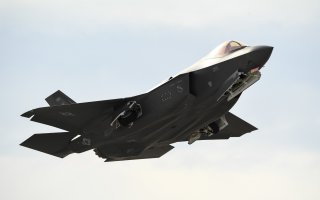Technical Difficulties: The F-35 Has a Touchscreen Problem
There are simply times where a touchscreen isn’t as intuitive as having buttons and keys.
Here's What You Need to Know: It looks like the expensive F-35 stealth fighter has yet another problem.
It has been over a decade since the original iPad was released and soon after the debate began on whether a tablet device could replace a laptop or even PCs in general. Even as recently as late 2018, the question was asked whether a touchscreen would be the new normal—but there are simply times where a touchscreen isn’t as intuitive as having buttons and keys.
The same issues are now being debated when it comes to the controls of modern aircraft, and last month an anonymous F-35 Lightning II pilot weighed in on the controls of the Lockheed Martin-built Joint Strike Fighter for the website Hushkitnet. The touchscreen controls may have streamlined the cockpit of the fifth-generation aircraft, but not always with the best results, the unnamed pilot suggested.
“The cockpit is beautiful to look at—nothing analogue, all digital with about 10 actual switches in the cockpit. Notice I say beautiful to look at, not necessarily beautiful to interact with! In theory the all-glass display is great. It’s [sic] touchscreen, you can set it up to show pretty much anything you want in any layout you want,” the pilot wrote.
The pilot then goes on to describe how the display can be utilized to show the aircraft’s fuel system, and how it can be customized to just what the pilot wants to see. However, using the touchscreen display in the cockpit while flying the advanced aircraft isn’t anywhere near the same as scrolling on a mobile phone or tablet screen while stretched out on the couch.
“The drawback is in the complete lack of tactile response. It can be challenging to press the correct ‘button’ on the display whenever the jet is in motion as it is quite a bumpy ride at times. At present I am pressing the wrong part of the screen about 20% of the time in flight due to either mis-identification, or more commonly by my finger getting jostled around in turbulence or under G. One of the biggest drawbacks is that you can’t brace your hand against anything whilst typing—think how much easier it is to type on a smartphone with your thumbs versus trying to stab at a virtual keyboard on a large tablet with just your index finger.”
The pilot shared similar thoughts about the F-35’s lack of heads up display (HUD), which is instead integrated into the very expensive flight helmet—which cost approximately $400,000 each!
“First up, there’s no HUD as its all integrated into the helmet. The technology of the helmet is great, but I’d take a HUD any day. It all comes down to physics—you can only shrink things so much before they start to become degraded, and HUDs have bigger optics than helmets…currently,” the pilot noted.
It is unclear if Lockheed Martin or the U.S. military will try to address the issues, but the United States Air Force has certainly done its part to help expedite the learning curve for pilots who are learning to fly the fifth-generation F-35 stealth fighter jet for the first time. The Air Force plans to achieve this feat by offering a set of specifics and training instructions from pilots to enable countries that are acquiring the F-35 jet for the first time to adjust to its technologies quickly.
Peter Suciu is a Michigan-based writer who has contributed to more than four dozen magazines, newspapers and websites. He regularly writes about military small arms, and is the author of several books on military headgear including A Gallery of Military Headdress, which is available on Amazon.com.
This article first appeared in February 2021.
Image: U.S. Air Force photo by R. Nial Bradshaw

